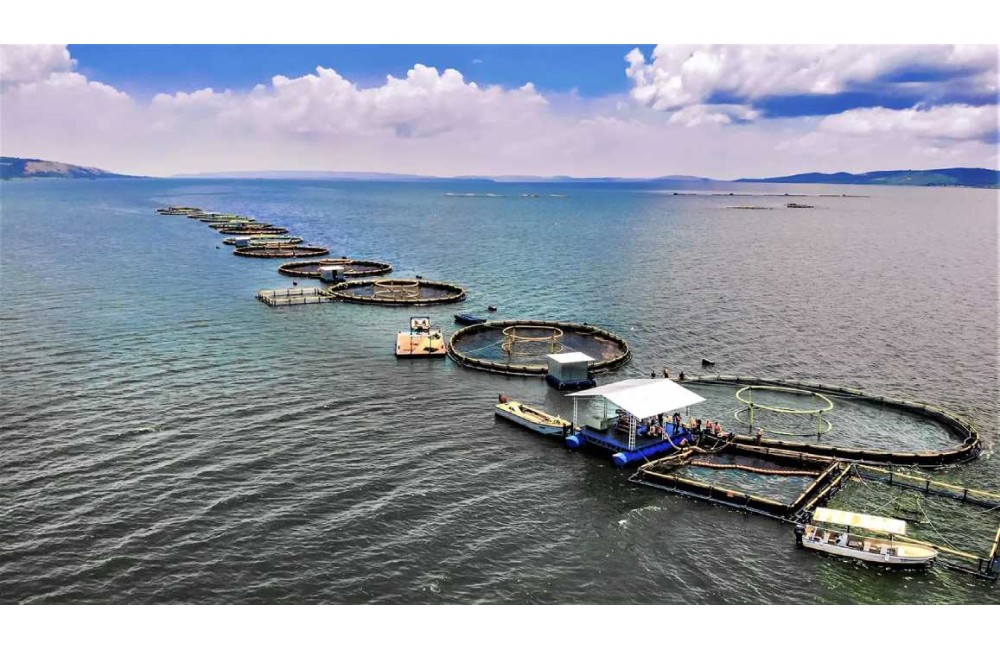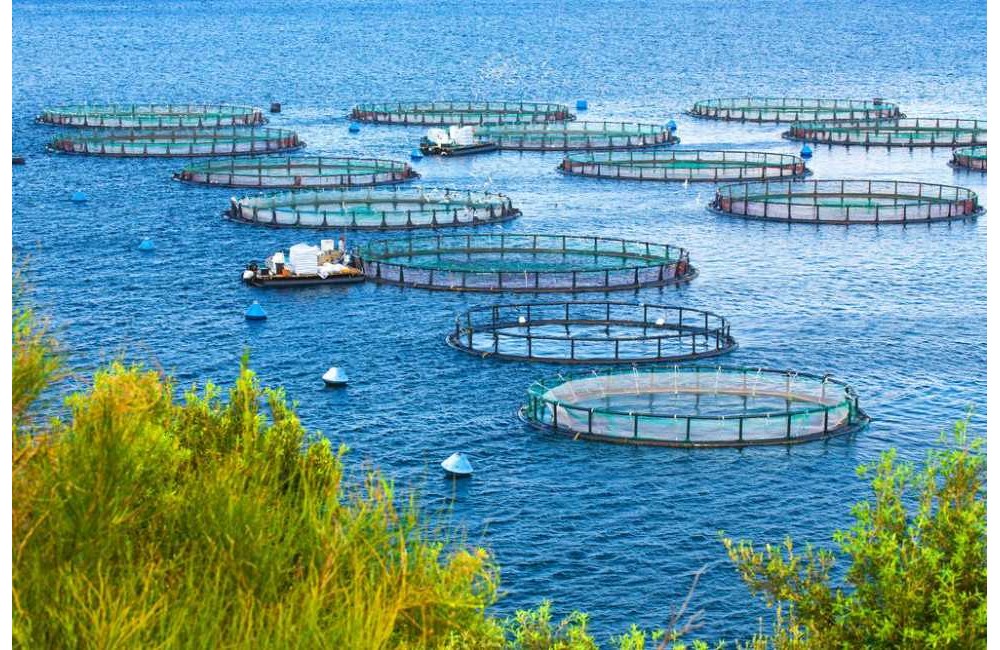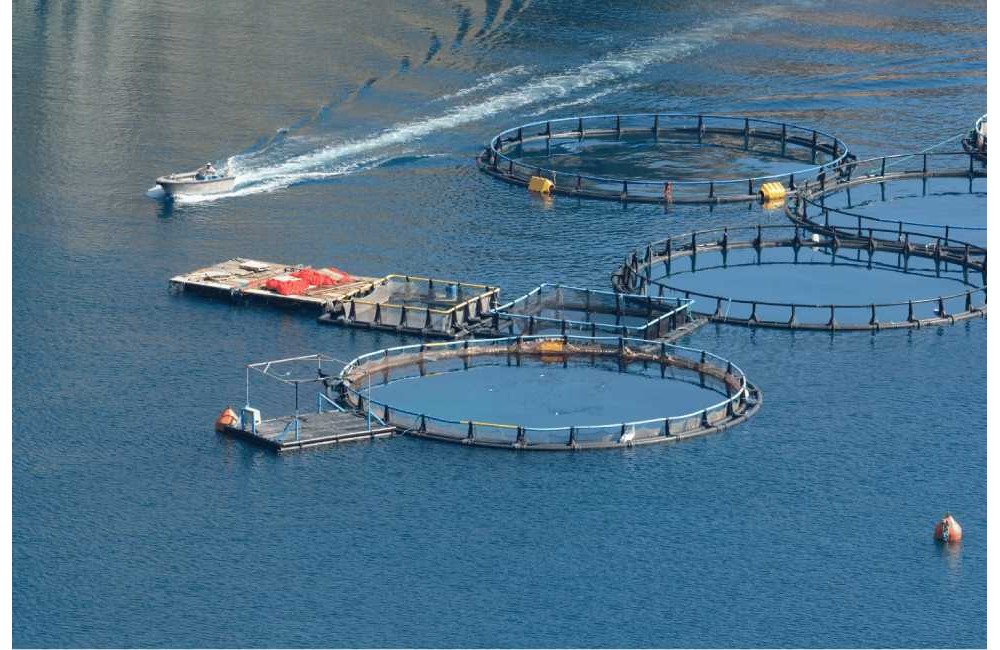

Fish for Good: Aquaculture's Protein Revolution
This study investigates the role of fisheries and aquaculture in providing
protein for human consumption. The Food and Agriculture Organization (FAO)
estimated that fisheries and aquaculture contributed 17% of global
animal-source protein for human consumption in 2018. This study aimed to assess
the protein quantities derived from these sectors and compare them to protein
production by terrestrial animals.
The analysis revealed that while aquaculture production surpassed fisheries
production in terms of live weight harvest (aquaculture: 82 million metric tons
vs fisheries: 74 million metric tons), fisheries contributed slightly more
protein (7.1 million metric tons) due to the composition of the catch. Aquaculture
tends to produce more molluscs (like clams and mussels) which have a lower
protein content compared to finfish and crustaceans typically caught by
fisheries.
On the other hand, total protein production from fisheries and aquaculture
combined reached 13.9 million metric tons, constituting 15.3% of all
animal-source protein for human consumption globally in 2018. This finding
aligns well with the FAO's estimate of 17.1%, highlighting the reliability of
the independent assessments.
Breaking down the sources of animal-source protein further, milk emerged as
the single largest contributor (30.9 million metric tons), followed by chicken
and other birds (15.4 million metric tons), pigs (9.9 million metric tons),
cattle (6.8 million metric tons), sheep and goats (2.3 million metric tons),
eggs (8.7 million metric tons), and other animals (1.2 million metric tons).
When focusing solely on edible meat protein, terrestrial sources provided
the majority (37.4 million metric tons), with fisheries and aquaculture contributing
13.9% and 13.3% respectively.
The study acknowledges that the reported protein content represents crude
protein, and actual protein content might be slightly lower due to the presence
of non-protein nitrogen. Taking this into account, the estimated true protein
amount from animal sources reached 82.5 million metric tons, translating to
10.85 kilograms per capita for the global population in 2018. Fisheries and
aquaculture specifically contributed 1.84 kilograms per capita of animal-source
protein.
The study emphasizes the crucial role of fisheries and aquaculture in
securing global protein supplies. With capture fisheries reaching a plateau,
the future of protein production from these sectors hinges on the continued
growth of aquaculture.
In conclusion, this study
highlights the significant contribution of fisheries and aquaculture to global
animal-source protein production. While efforts to increase plant-based protein
consumption are ongoing, animal proteins remain a vital source due to their higher
protein concentration and essential amino acid profile. The study underscores
the importance of sustainable aquaculture development to meet the rising demand
for animal-source protein in the foreseeable future.

Sustainable Seas? The Truth About Fish Farming
Aquaculture, the practice of raising fish and other aquatic animals in a
controlled environment, has been a topic of debate for decades. While its
original intention was to increase food security, concerns regarding its
environmental impact have overshadowed its potential benefits. However, recent
advancements in technology and regulations have paved the way for sustainable
aquaculture practices.
Past Concerns and Their Causes
Early aquaculture practices faced criticism due to several factors. High
fish density in farms led to nutrient and effluent buildup, potentially
depleting oxygen levels and creating algal blooms. The overuse of antibiotics
to prevent diseases raised concerns about their impact on surrounding
ecosystems. Additionally, escapes of non-native fish species posed a threat to
native fish populations.
Addressing Environmental Issues
Regulatory bodies have implemented stricter measures to prevent negative
environmental impacts. Strategic farm siting with strong currents helps
disperse effluents, and rotating farm locations minimizes the impact on any
single area. Land-based aquaculture offers an alternative with minimal impact
on local ecosystems.
The use of antibiotics is declining as safe and effective vaccinations for
farmed fish are becoming widely used. Underwater cameras and regular
inspections of cages help prevent fish escapes.
Sustainable Advantages of Aquaculture
Farmed seafood boasts a significant advantage in resource efficiency compared
to other animal proteins. With a feed conversion ratio of 1.1, it essentially
produces one pound of protein for every pound of feed used. This ratio is
significantly lower than beef, pork, and chicken.
Close monitoring of farmed fish allows for greater control over
environmental contaminants. Farmed fish typically consume human-processed feed
with regulated toxin levels, minimizing their exposure to mercury and heavy
metals.
Shellfish aquaculture can improve water quality by filtering out excess
nutrients, preventing effluent buildup. Integrating them with finfish farms
(polyculture or IMTA) creates a symbiotic system where shellfish consume
uneaten feed and fish waste, further reducing the farm's environmental
footprint.
The Rise of Sustainable Practices
The aquaculture industry is actively seeking ways to lessen its
environmental impact. Sustainable fish feeds are gaining traction, with
fishmeal and fish oil being replaced by trimmings from processing plants and
plant-based proteins.
Conclusion
Aquaculture has undergone significant improvements in recent years, making
it a viable solution to meet the growing global demand for seafood. Sustainable
practices are readily available, and it is up to the industry to embrace them.
Farmed fish should no longer be dismissed as unsustainable; it can be a
resource-efficient protein source for a growing population.

Navigating the Blue Revolution Innovation in aquaculture farming
India's coastline and freshwater resources have nurtured a thriving aquaculture industry. This sector, fueled by rising demand for seafood, has grown at an impressive 8% annually since 2015. In 2022, seafood exports hit a record $7.08 billion, showcasing the immense potential.
( https://inc42.com/resources/how-tech-innovation-is-reshaping-aquaculture-in-india/ )
Dominant Species and Government Support
Fish and shrimp are the mainstays of Indian aquaculture. Shrimp production
has skyrocketed by 10% annually, reaching 700,000 metric tonnes in 2022. Fish
production has grown at 8% annually, reaching 1.2 million metric tonnes the
same year.
The Indian government actively supports this growth. The National Fisheries
Development Board (NFDB) and the Marine Products Export Development Authority
(MPEDA) provide financial aid and supportive policies. Significant funding has
been allocated for infrastructure development and technology adoption. The Blue
Revolution Scheme, launched in 2022-2023 with a budget of INR 1,800 Cr,
exemplifies the government's commitment to sustainable development in fisheries
and aquaculture.
Tech Revolutionizes Aquaculture
Technology is transforming Indian aquaculture. Traditional practices are
giving way to modern farm management systems, significantly improving
productivity and sustainability. Over 60% of farmers have adopted
technology-driven practices, resulting in a 25-30% yield increase and a 10-15%
reduction in feed conversion ratios (CII survey).
Data-Driven Approach for Better Decisions
Data analytics plays a crucial role. IoT devices and sensors deployed in
farms collect real-time data on water quality, oxygen levels, and feed
management. Analyzing this data empowers farmers to proactively prevent disease
outbreaks, optimize feed utilization, and gain valuable insights into fish or
shrimp health. This data-driven approach not only reduces production risks but
also leads to substantial cost savings.
AI and ML Shaping the Future
The integration of data analytics with artificial intelligence (AI) and
machine learning (ML) is revolutionizing aquaculture practices. AI-powered
systems, coupled with extensive data analysis, enable farmers to make informed
decisions and predict market trends. A study by the Indian Council of
Agricultural Research (ICAR) found that implementing AI algorithms in disease
detection resulted in a 40% reduction in disease-related losses, saving farmers
an estimated INR 500 Cr annually.
Innovative Methods for Sustainable Practices
Recirculating aquaculture systems (RAS) are gaining popularity due to their
ability to maintain optimal water conditions while minimizing water usage.
These systems utilize advanced filtration and water treatment mechanisms. The
MPEDA reports a 35% increase in RAS adoption over the past three years,
contributing to improved water management and a reduction of up to 90% in water
consumption compared to traditional pond-based systems.
Genetics for Enhanced Productivity
Selective breeding and genetic engineering techniques are playing a pivotal
role in improving the quality and productivity of aquaculture species. The NFDB
highlights a 20% increase in the adoption of genetically improved fish
varieties over the past five years. These advancements have led to the
development of disease-resistant, fast-growing, and high-yielding fish
varieties, significantly improving production efficiency and profitability for
farmers.
A Diversifying Export Portfolio
The growth in fish and shrimp production has significantly impacted India's
seafood exports. In 2022, India exported approximately 1.48 million metric
tonnes of seafood, valued at $7.08 billion. Shrimp exports, valued at $4.6
billion, constitute a major portion of this total. Technology-driven practices
and efficient supply chain management ensure high-quality seafood reaches
global markets.
India's aquaculture industry is strategically moving beyond shrimp. Fish
exports have witnessed a steady rise, with popular varieties like Indian
mackerel and tuna finding growing demand internationally. Advanced technologies
in fish breeding, processing, and preservation are helping maintain product quality
and freshness.
The Future: Embracing Technology for Sustainability
Technology integration throughout the aquaculture value chain has been
instrumental in propelling India's seafood exports and ensuring sustainable
practices. By embracing continued technological advancements, India can
solidify its position as a global leader in aquaculture, boost domestic
production, meet rising consumer demand, and contribute to food security.

Seeding the Future: Aquafarms Get Smart
India's coastline and freshwater resources have nurtured a thriving aquaculture industry. This sector, fueled by rising demand for seafood, has grown at an impressive 8% annually since 2015. In 2022, seafood exports hit a record $7.08 billion, showcasing the immense potential.
Dominant Species and Government Support
Fish and shrimp are the mainstays of Indian aquaculture. Shrimp production has skyrocketed by 10% annually, reaching 700,000 metric tonnes in 2022. Fish production has grown at 8% annually, reaching 1.2 million metric tonnes the same year.
The Indian government actively supports this growth. The National Fisheries Development Board (NFDB) and the Marine Products Export Development Authority (MPEDA) provide financial aid and supportive policies. Significant funding has been allocated for infrastructure development and technology adoption. The Blue Revolution Scheme, launched in 2022-2023 with a budget of INR 1,800 Cr, exemplifies the government's commitment to sustainable development in fisheries and aquaculture.
Tech Revolutionizes Aquaculture
Technology is transforming Indian aquaculture. Traditional practices are giving way to modern farm management systems, significantly improving productivity and sustainability. Over 60% of farmers have adopted technology-driven practices, resulting in a 25-30% yield increase and a 10-15% reduction in feed conversion ratios (CII survey).
Data-Driven Approach for Better Decisions
Data analytics plays a crucial role. IoT devices and sensors deployed in farms collect real-time data on water quality, oxygen levels, and feed management. Analyzing this data empowers farmers to proactively prevent disease outbreaks, optimize feed utilization, and gain valuable insights into fish or shrimp health. This data-driven approach not only reduces production risks but also leads to substantial cost savings.
AI and ML Shaping the Future
The integration of data analytics with artificial intelligence (AI) and machine learning (ML) is revolutionizing aquaculture practices. AI-powered systems, coupled with extensive data analysis, enable farmers to make informed decisions and predict market trends. A study by the Indian Council of Agricultural Research (ICAR) found that implementing AI algorithms in disease detection resulted in a 40% reduction in disease-related losses, saving farmers an estimated INR 500 Cr annually.
Innovative Methods for Sustainable Practices
Recirculating aquaculture systems (RAS) are gaining popularity due to their ability to maintain optimal water conditions while minimizing water usage. These systems utilize advanced filtration and water treatment mechanisms. The MPEDA reports a 35% increase in RAS adoption over the past three years, contributing to improved water management and a reduction of up to 90% in water consumption compared to traditional pond-based systems.
Genetics for Enhanced Productivity
Selective breeding and genetic engineering techniques are playing a pivotal role in improving the quality and productivity of aquaculture species. The NFDB highlights a 20% increase in the adoption of genetically improved fish varieties over the past five years. These advancements have led to the development of disease-resistant, fast-growing, and high-yielding fish varieties, significantly improving production efficiency and profitability for farmers.
A Diversifying Export Portfolio
The growth in fish and shrimp production has significantly impacted India's seafood exports. In 2022, India exported approximately 1.48 million metric tonnes of seafood, valued at $7.08 billion. Shrimp exports, valued at $4.6 billion, constitute a major portion of this total. Technology-driven practices and efficient supply chain management ensure high-quality seafood reaches global markets.
India's aquaculture industry is strategically moving beyond shrimp. Fish exports have witnessed a steady rise, with popular varieties like Indian mackerel and tuna finding growing demand internationally. Advanced technologies in fish breeding, processing, and preservation are helping maintain product quality and freshness.
The Future: Embracing Technology for Sustainability
Technology integration throughout the aquaculture value chain has been instrumental in propelling India's seafood exports and ensuring sustainable practices. By embracing continued technological advancements, India can solidify its position as a global leader in aquaculture, boost domestic production, meet rising consumer demand, and contribute to food security.